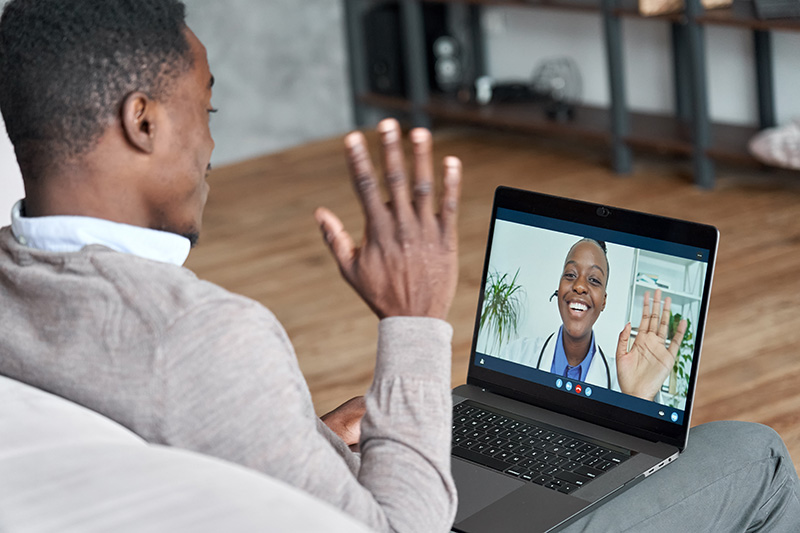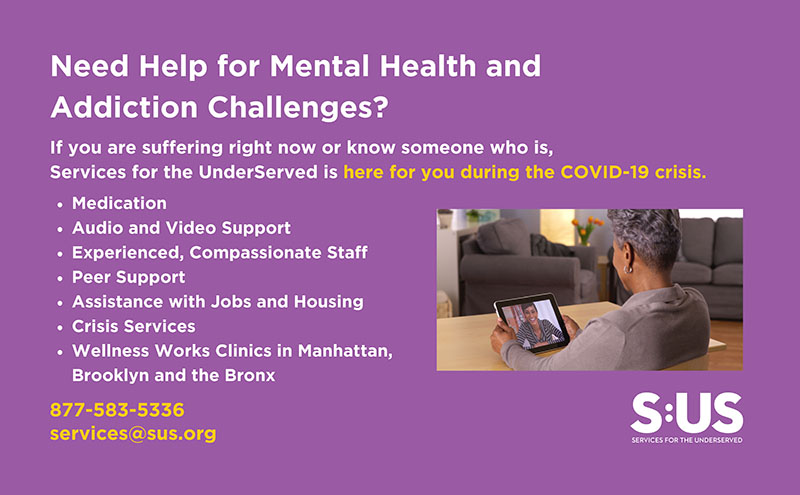This article is part of a quarterly series giving voice to the perspectives of individuals with lived experiences as they share their opinions on a particular topic. The authors are served by Services for the UnderServed (S:US), a New York City-based nonprofit that is committed to giving every New Yorker the tools that they can use to lead a life of purpose.
We are three New Yorkers who receive supported housing, mental health, case management, and substance use treatment and recovery services from Services for the UnderServed (S:US). Like everyone else, our lives have been full of upheaval over the last year because of the COVID-19 pandemic. We have embraced technology in different ways to help support our behavioral health and keep our lives moving forward during this time of isolation. S:US has helped us by using technology for telehealth and other services and by supporting their staff so they can safely help us meet our needs.

Barriers to Telehealth
When the pandemic first started, some of us had trouble with technology because we weren’t familiar with how to use it. For example, one of us tried to do a video chat and couldn’t get through so we just called on the phone instead. We’ve also experienced our video freezing or the internet cutting out, which makes it more difficult.
For parents with children still at home, they may help teach us technology, but they also add challenges. A younger child doesn’t understand when you can’t pay attention to them. It’s hard to find time to have calls, not be interrupted, and have our minds focus on one thing. “When you’re in the office, you don’t have to worry about these things. When you’re at home, there’s a whole world of stuff going on,” said Trina.
Some of our peers have barriers to technology, they don’t have smartphones, they’re concerned about using up their data or minutes, they don’t have laptops or they don’t have Wi-Fi. One of us reached out to our peers to show them how to use tools like Zoom and other things. This is something that S:US staff has helped us with too.
And one of us wishes that their primary care provider had more time to spend with patients instead of having an overwhelming workload and limited services.
The Convenience of Telehealth
Two of us really appreciate the convenience of telehealth. Once we learned how to use it, it’s easy to make appointments and talk with our providers. We like not having to travel and take public transportation to get to our appointments.
“Before the pandemic, I’d come into the clinic from the subway, frustrated and stressed by the trip. Now when I log on, I have a clear mind for therapy,” said Jeffery.
“My doctor is very nice. He Zooms with me every month. My therapist calls me every two weeks and checks on me. We talk about current events, vaccinations, family, work, my medication—everything that matters. I look up to them. If I have any problems, I can talk with them. I wish I could see them in person, but telehealth works fine for me,” said Ephraim.
We like being able to get the support we need, when we need it. And one of us has also found that some things that are hard to discuss in person with our providers are easier to talk about over the phone.
Missing In-Person Interactions
We all enjoy being around people and we each consider ourselves as a “people person.” In person you can tell a lot by someone’s body language and that’s missing in telehealth. We all think that it’s good to see people face-to-face and that eye contact is essential when you have conversations with people. That makes in-person conversations more comfortable for us. Video chats are helpful, but the phone is more impersonal. Trina said, “On the phone, I don’t know what the other person is doing or if they’re listening to me.” And there are some things that can’t be done via telehealth—like hip replacements!
One of us belongs to the Brooklyn Clubhouse, which is a program that supports people living with mental illness, offers GED and basic computer training, as well as skills development in food service, facilities management, computer applications, and office work. The Clubhouse provides valuable social and vocational opportunities, support from peer advocates, and assistance in developing critical life coping skills and employment readiness.
“The Clubhouse is vital for us because it gives us structure and keeps us functioning, so we don’t get bored or stressed or relapse. We help each other. It’s a wonderful place. Now we use Zoom, which helps us keep our focus on our health and communicate with one another. It’s not the same as when I’m there in person, but I still get to see a lot of members. It makes me feel good and helps me with my quality of life. But I miss being around people. Being around people makes me feel happy,” said Ephraim.
Learning to Use Technology
All three of us are older and didn’t really use social media or video chat tools before the pandemic. We had to learn how to use these tools. Fortunately, for one of us, the internet speed has improved during the pandemic.
“I learned how to use technology better in the past year. I did not know how to Zoom before. I understand technology better and I don’t have to go to my son for every little thing. I’ve been able to do things for myself, like set up appointments and check information in my online medical chart, which has been a great help. I also understand the medical terminology better because while I’m looking at it, I can look up the terms online,” said Trina.
Using Technology to Connect
One of us mostly uses video chat to help her children with school and keeps them busy with online activities. “Online activities are fun for the kids and keeps them occupied. But I haven’t done many myself. I don’t find it interesting. Sometimes I tell myself to try it out, but if it’s not hands-on, I just watch it,” said Trina.
In addition to outpatient treatment, wellness and recovery sessions, and self-improvement workshops, one of us is applying for a Credentialed Alcoholism and Substance Abuse Counselor (CASAC) certification and plans to do the training online. “I have a history of substance use and have been recovering for a long time. It’s time for me to use my life history to be able to help other people. At my age, as a senior citizen, I still struggle with mental illness and other things. I’ve been through it so I want to help other people going through it,” said Jeffery.
Ephraim said, “It’s very important that we have Zoom. This way, we can be together as a Clubhouse community and talk about important things. We laugh and have fun and talk about our lives, our homes, our health, cooking, gardening, and also about improving our quality of life. This group helps me to be myself, to be a better person. They also helped me get a job through the Transitional Employment Program that operates out of Clubhouse. I’ve seen myself flourish—I’ve come a long way.”
Survey on COVID-19 Impact
In November, S:US sent an anonymous survey to us and other people they serve that focused on the impact of COVID-19. S:US staff and members of the Clubhouse helped create questions about potential needs that we have faced during the pandemic and potential barriers to video conferencing. S:US received 3,458 responses, which is 60% of people served.
The key findings from the survey generally support what we have shared about our experiences in this article.
Barriers to video conferencing:
- 32% of people surveyed stated they had no barriers or concerns.
- 1 in 4 people stated they needed a device (smart phone, tablet, or laptop).
- 1 in 5 stated poor or no internet or WiFi.
- 26% stated they need to learn how to use video conferencing apps like Zoom.
- Only 13% stated they are uncomfortable being on camera.
- Only 9% stated they don’t have a private space.
- On average, people stated they have two barriers (out of eight possible options).
Statistically significant trends with age:
- Younger clients stated greater needs, particularly in meeting education/vocational goals and support with food.
- Older clients stated greater barriers to video conferencing, including needing a device, more data plans, and learning to use the apps. This was most true for individuals 55 years old and older.
- The preference to meet in person increased with age.
Statistically significant trends with gender:
- Men stated a more negative emotional impact from COVID-19 than women; on average, men stated having more needs and more barriers compared to women.
General emotional impact of COVID-19 trends:
- The more impacted by COVID-19 an individual was, the more needs they faced and barriers to video conferencing they presented.
- Conversely, individuals who were less negatively impacted by COVID-19, felt they had greater support from S:US and were comfortable meeting with S:US staff and medical providers via video conferencing.
Looking Forward
As spring blooms in New York City, we see hope on the horizon. We appreciate the support from S:US and are glad that we’ve gained some new skills and better understand technology. We’re also really looking forward to seeing people in person again!
“Everything I’ve said is from the heart. These times are very serious. Life is serious—I never take things for granted. I’m grateful that I can sit here and talk to you,” said Ephraim.








